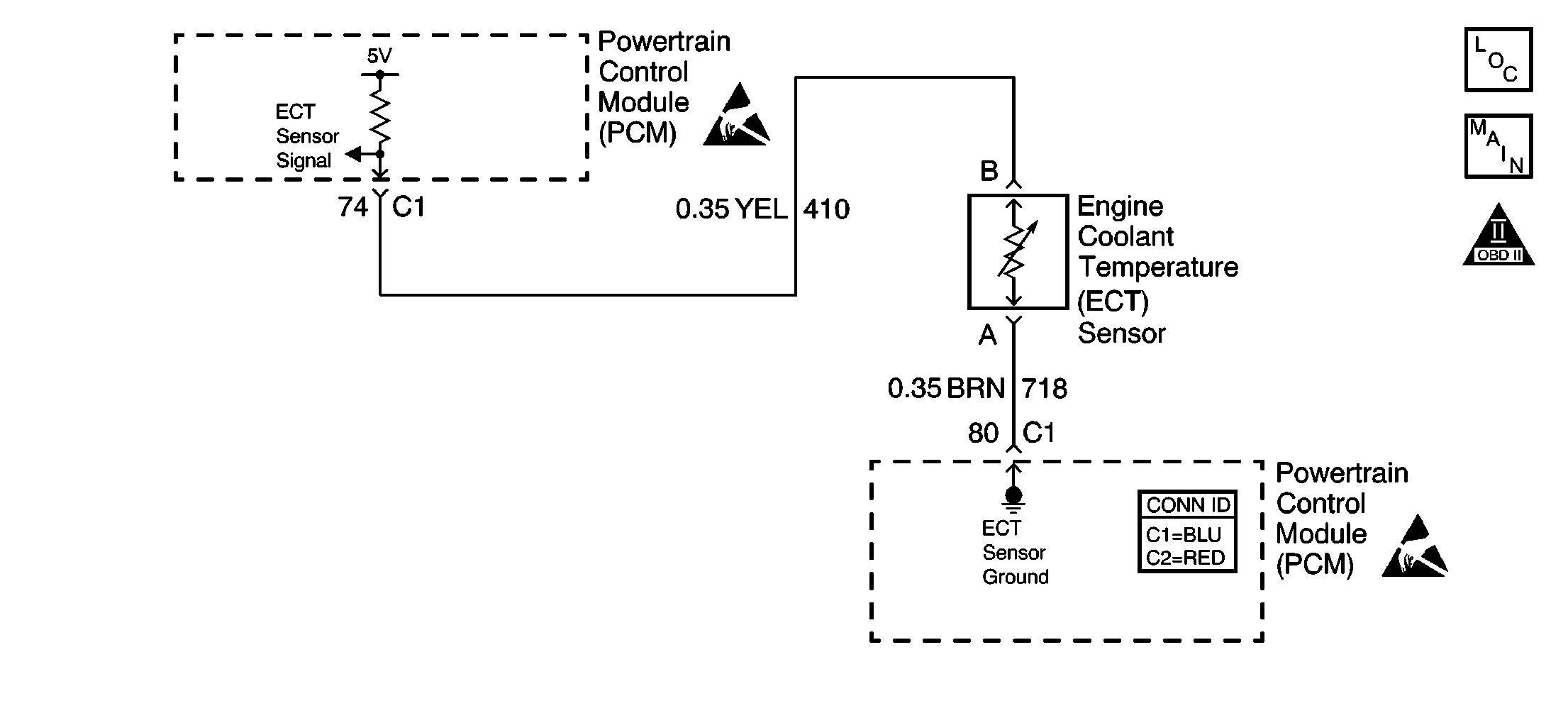
Circuit Description
The engine coolant temperature (ECT) sensor contains a semiconductor device which changes resistance based on temperature (a thermistor). The ECT sensor mounts in the left bank cylinder head near the front of the engine. The ECT sensor has a signal circuit and a ground circuit. The PCM applies a voltage, which is about 5 volts, on the signal circuit to the sensor. The PCM monitors changes in this voltage caused by changes in the resistance of the sensor in order to determine the engine coolant temperature.
When the PCM senses a signal voltage higher than the normal operating range of the sensor, this DTC sets.
Conditions for Running the DTC
Engine operates longer than 60 seconds.
Conditions for Setting the DTC
| • | The PCM indicates that the Engine Coolant Temperature is less than -35°C (-31°F). |
| • | The intermittent condition exists for a total of 1.0 second during a 20.0 second time period. |
Action Taken When the DTC Sets
| • | The powertrain control module (PCM) stores the DTC information into memory when the diagnostic runs and fails. |
| • | The malfunction indicator lamp (MIL) will not illuminate. |
| • | The PCM records the operating conditions at the time the diagnostic fails. The PCM stores this information in the Failure Records. |
Conditions for Clearing the DTC
| • | A last test failed, or current DTC, clears when the diagnostic runs and does not fail. |
| • | A history DTC will clear after 40 consecutive warm-up cycles, if no failures are reported by this or any other non-emission related diagnostic. |
| • | Use a scan tool in order to clear the DTC. |
Diagnostic Aids
Important:
• Remove any debris from the PCM connector surfaces before servicing
the PCM. Inspect the PCM connector gaskets when diagnosing/replacing
the module. Ensure that the gaskets are installed correctly. The
gaskets prevent contaminate intrusion into the PCM. • For any test that requires probing the PCM or a component
harness connector, use the Connector Test Adapter Kit J 35616
. Using this kit prevents damage
to the harness/component terminals. Refer to
Using Connector Test Adapters
in Wiring Systems.
| • | Electromagnetic interference (EMI) can cause an intermittent DTC. Inspect the related circuits for being too close to secondary ignition wires and the generator. |
| • | If the engine sat overnight, the engine coolant temperature and intake air temperature values should display within a few degrees of each other. If the temperatures are not within 3°C (5°F), refer to Temperature Versus Resistance table. |
| • | For an intermittent, refer to Symptoms . |
Test Description
The numbers below refer to the step numbers on the diagnostic table.
-
If DTC P0118 failed this ignition, this indicates a hard failure is present. When a hard failure is present, both the hard and intermittent DTCs set.
-
When moving related connectors, visually/physically inspect connectors for the following:
-
When moving the related wiring harnesses, visually/physically inspect the wiring for the following:
-
Using the Freeze Frame and/or Failure Records data may aid in locating an intermittent condition. If you cannot duplicate the DTC, the information included in the Freeze Frame and/or Failure Records data can help determine how many miles since the DTC set. The Fail Counter and Pass Counter can also help determine how many ignition cycles the diagnostic reported a pass and/or a fail. Operate the vehicle within the same freeze frame conditions (RPM, load, vehicle speed, temperature, etc.) that you observed. This will isolate when the DTC failed.
| • | Poor mating of the connector halves or a terminal not fully seated in the connector body (backed out). |
| • | Improperly formed or damaged terminals. Carefully reformed or replaced all connector terminals in the related circuits in order to insure proper terminal contact tension. |
| • | Poor terminal to wire connection. Inspect for poor crimps, crimping over wire insulation rather than the wire. |
| • | Dirt or corrosion on the terminals. Inspect the connector seals for being there and for being damaged. |
| • | Wire insulation that is rubbed through, causing an intermittent short. |
| • | Wiring broken inside the insulation. |
Step | Action | Values | Yes | No |
|---|---|---|---|---|
1 | Did you perform the Powertrain On-Board Diagnostic (OBD) System Check? | -- | ||
Did DTC P0118 Fail This Ignition cycle? | -- | Go to DTC P0118 Engine Coolant Temperature (ECT) Sensor Circuit High Voltage | ||
Does the sensor value change abruptly while a related connector is being moved? | -- | |||
Observe the affected sensor value on the scan tool while moving the related wiring harnesses. Does the sensor value change abruptly while moving the related electrical harnesses? | -- | |||
Does the scan tool indicate that this diagnostic failed this ignition? | -- | Go to Diagnostic Aids | ||
6 | Repair the damage connectors/terminals. Refer to Repairing Connector Terminals in Wiring Systems. Is the action complete? | -- | -- | |
7 | Repair the faulty wiring. Refer to Wiring Repairs in Wiring Systems. Is the action complete? | -- | -- | |
8 |
Is the action complete? | -- | -- | |
9 |
Does the scan tool indicate that this test ran and passed? | -- | ||
10 | Select the Capture Info option and the Review Info option using the scan tool. Does the scan tool display any DTCs that you have not diagnosed? | -- | Go to the applicable DTC table | System OK |
